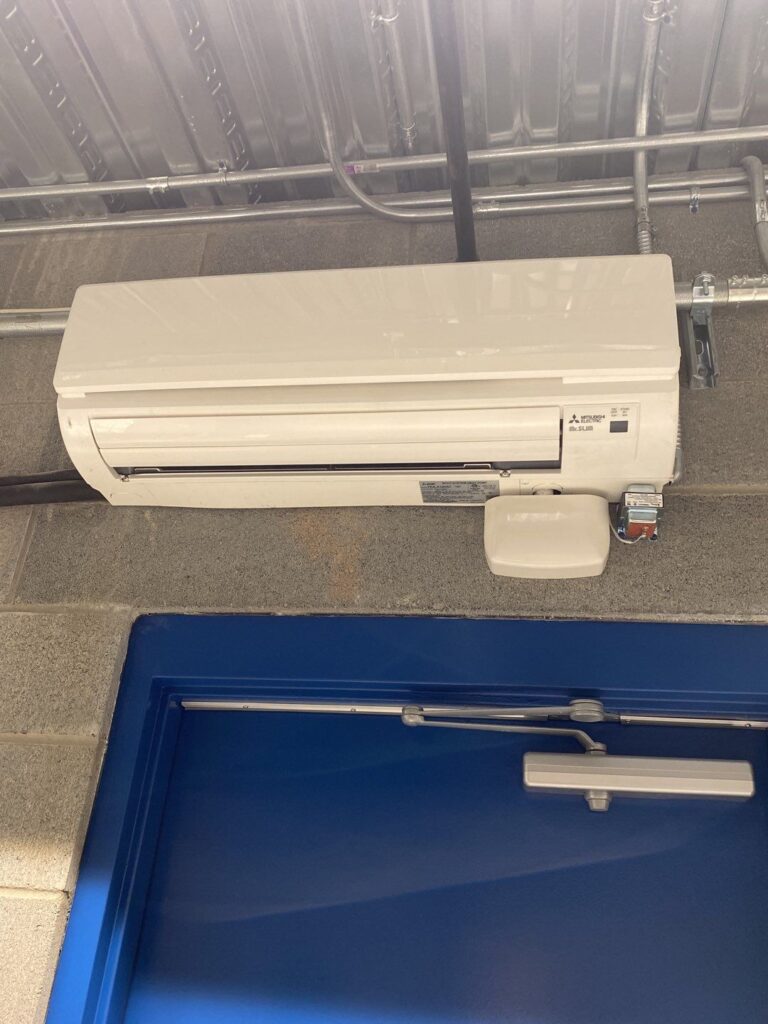Without a doubt, AC coil cleaning is the most straightforward and economical method to increase its efficacy, longevity, and durability. Additionally, it improves internal comfort and reduces maintenance and repair expenses.
Due to these advantages, annually AC coil cleaning should be a priority. Following an initial period of adjustment to cleaning the coils, subsequent cleanings will proceed considerably more effortlessly and quickly.
Types of AC Coils
The air that is cooled by your central air conditioning system is produced by two sets of coils. Evaporator coils cools the air and condenser coils absorbs heat. Each set of coils requires a thorough cleaning.
Condenser Coils
Coils are housed within the condenser, which is a sizable outdoor metal unit. Hot air is extracted and dissipated by condenser coils.
Condenser coils consist of aluminium fins encircling metal tubing. Compressing gaseous refrigerant within the coils causes the gas to condense into a heated liquid. The heat is dissipated as the liquid passes through the condenser coils and fins. A substantial electric fan positioned atop the condenser aids in the dissipation of heat.
Evaporator Coils
Evaporator coils are situated in close proximity to the air receiver indoors. Coiled evaporators become extremely chilly. Cool air is blown into the home via the evaporator coils as blower air passes through them.
Evaporator coils, akin to condenser coils, traverse aluminium fins. After traversing the condenser coils, the refrigerant proceeds indoors to the evaporator coils. The coils are cooled as the refrigerant liquid expands into a gas upon entering.
When to Clean Air Conditioner Coils
Annually, you should do AC coil cleaning. If you have a dirty exterior or interior, or if you frequently use your AC, clean the coils more frequently.
AC coil cleaning should be done in spring and possibly again in midsummer.

Why is it Important To Clean AC Coils?
Surface moisture from the cooling process, the close proximity of the coil fins, and the volume of air that traverses them can all contribute to the accumulation of grime, dust, debris, and other contaminants on the surfaces of the coils. This accumulation diminishes the system’s capacity to transmit heat into and out of the residence over time, thereby diminishing the system’s ability to offer summer cooling.
In more severe circumstances, clogged coils may obstruct or impede the circulation, which is vital to the operation. This may lead to decreased indoor comfort and increased utility expenses as a consequence of compromised energy efficiency. Worse yet, clogged coils force the system to operate at an excessively high level, which may lead to premature system failure and potentially costly repair expenses. To put it simply, an air conditioning system will function more efficiently if the coil is kept clear.
Dirty coils can lead to:
Increased operating temperatures
An overabundance of dirt and detritus can impose unnecessary strain on the system, necessitating higher operating temperatures and increased effort from fans and compressors in order to attain the intended indoor comfort.
Reduced comfort. An undesirable and unpleasant level of humidity is naturally extracted from your residence by your air conditioning system as part of the cooling process. Dirty coils can diminish the overall efficiency of a system, resulting in increased indoor humidity and diminished comfort.
Decreased cooling efficiency. The accumulation of debris on the coil surfaces necessitates increased effort from the coils to absorb or discharge heat, ultimately leading to a reduction in operational efficiency.
Increased cooling costs. Operating inefficiently results in increased operating expenses. Having dirty coils increases the cost of cooling the space.
Increased system wear. When the evaporator coil becomes obstructed, the compressor frequently operates at elevated temperatures, which exerts strain on the entire system. Due to the fact that the compressor is one of the most expensive replacement components in an air conditioning system, safeguarding it can prevent costly repairs.
System repairs or replacement. System failures caused by components that are overworked may necessitate service calls, component replacements, or even system replacements as a last resort.
How often Should AC Coils be Cleaned?
It is logical to assume that AC coils ought to be cleansed when they become dirty. However, the rate at which they become soiled is contingent upon several factors, including the frequency of air conditioning usage, filter replacement (if present), airborne dust and detritus levels inside and outside the residence, and the number of occupants occupying the area.
We recommend that, at the very least, you have an HVAC professional perform a system maintenance inspection once a year. It should be prior to the peak summer season, when your air conditioner will be in highest demand. They are capable of AC coil cleaning, replacing AC filters, and testing the system to ensure that everything is operating. Utilizing our online scheduling utility has further simplified the process of scheduling services. Simply locate the orange “Schedule Now” icon next to the contact information of each participating dealer.
How to Clean an Air Conditioner
Due to the critical nature of air conditioner coils in relation to both comfort and system efficiency, proper installation is essential. It is also crucial to protect the coil fins, which aid in the heat transfer process, from injury during the cleaning process, given their delicate nature.
We therefore advise employing a professional to clean your coils on a routine basis. It is most prudent to have a trained Cool Breeze Services professional service your air conditioner in order to guarantee its optimal performance and durability. In addition to being adequately trained in the process of cleaning AC coils, they possess the capability to conduct pre-cooling season system testing to verify optimal operation of your system. Nevertheless, having knowledge of the processes and methodologies associated with air conditioner coil cleansing will enable you to anticipate certain outcomes and communicate your concerns with your local HVAC dealer more effectively. The subsequent sections provide detailed descriptions of the methodologies and procedures.
Getting to the Air Conditioning Coils
An outdoor condensing coil and an interior evaporator coil are both components of air conditioning systems. Typically, the indoor evaporator coil is contained within a fan coil or air handler device, or it is mounted to the boiler and has its own cabinet. Although every model is slightly different, the evaporator coil is typically accessible to your Cool Breeze Services expert via an access panel that requires a nut driver or screwdriver to remove.
Typically, the condenser coil in the outdoor unit encircles the interior components and functions as the exterior unit’s side walls. Either it is exposed and shielded by a robust wire coil guard, or it is concealed by a louvred metal outer panel that provides additional protection. There are circumstances in which the outer casing and cap may require removal. Your dealer will inspect the coils once they are exposed and accessible, and will then determine the most effective cleaning method in accordance with the manufacturer’s guidelines. This may involve the utilization of a specialized fin-straightening instrument to straighten bent fins.
Methods for Cleaning Air Conditioners
How to Clean AC Coils with Compressed Air
Your dealer may utilize a combination of shop-vacs, heavy-duty coil-cleaning chemicals, compressed air, and shop-vacs, depending on the model specifications of your air conditioner. Generally, this technique is restricted to outdoor condensing coils. Compressed air used to clean the interior evaporator coil will blow dust and debris throughout the residence. As a rapid and reasonably effective method for removing surface dust, dirt, and debris from the coil, compressed air may be utilized.
When performing compressed air cleaning on outdoor coils, an HVAC technician will apply the air in the opposite direction of the coil’s normal airflow. As a consequence, air will be forced from the cleansed side back into the dirtier side. Your dealer will ensure that the air is blown through the fins in a direct line, not at an angle. This is because the fins are made of extremely thin, pliable metal. The service technician can subsequently eliminate the undesirable dirt and detritus from the unit by utilizing the shop vac. These operations will primarily eliminate loose, outermost substances from the filament.
How to do AC Coil Cleaning with Household Detergent
Although numerous commercially available solutions exist for cleaning coils, air conditioner coils can also be effectively cleansed using a solution composed of water and a mild household detergent. The coil is treated with the detergent and water solution via low-pressure spraying. After allowing the coil to discharge naturally, it is rinsing it lightly with a garden hose. There is no need to repeat this procedure.
Ensure that a contractor employing this technique is utilizing a low-pressure sprayer and not a pressure washer. They should never use a pressure washer on the coil’s thin metal fins, as the high-powered discharge will almost certainly cause damage. A bend or damage to the fins may obstruct ventilation, leading to a decrease in the ability to transfer heat. Additionally, ensure they are not employing a highly acidic detergent. Acidic cleansers have the potential to cause corrosion in the copper and alloy metals utilized in the coil, thereby diminishing its lifespan.
How to Clean AC Coils with Commercial Cleaners
A Cool Breeze Services expert may elect to utilize commercially available coil cleaning solutions for your AC coil cleaning. There are numerous varieties, including outdoor foaming cleansers. These are readily available in volume or in aerosol cans for use in low-pressure sprayers. The contractor will likely remove any surface detritus from your outdoor coil by hand or using a specialized fin brush. After administering the commercial cleaner, they will rinse the coil with water in accordance with the manufacturer’s guidelines and the cleaner’s instructions. In order to clean your indoor evaporator coil, the contractor will likely use water and moderate detergent after removing larger debris by hand or with a specialized brush.
AC Coil Cleaning is Cost-Effective
Although there may be householders who are tempted to attempt AC coil cleaning themselves using the aforementioned methods. It is advisable to hire a reputable HVAC professional for the job. Consistent coil cleaning services are considerably more cost-effective than expensive repairs that may ensue from neglecting this maintenance component. Certain HVAC dealers even offer discounted “clean and check” specials, further reducing the cost of the service. An alternative approach would be for some to provide a service contract encompassing routine inspections and cleanings, a warranty against malfunction, or a reduced rate on repairs.
The extended lifecycle of the system, sustained energy efficiency, decreased operating costs, improved comfort, and diminished likelihood of extensive repairs all contribute to the cost-effectiveness of AC coil cleaning as a system maintenance practice. Make service an appointment by contacting the Cool Breeze Services HVAC specialist in your area. They will perform the maintenance and care required. They will ensure that your air conditioning system operates efficiently and effectively throughout the entire season.
